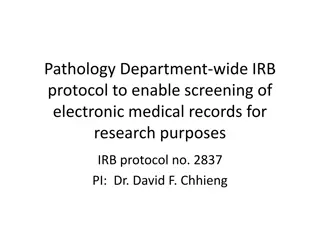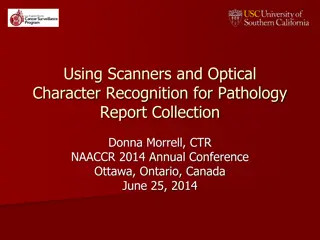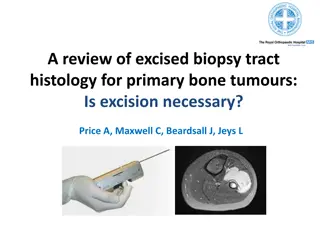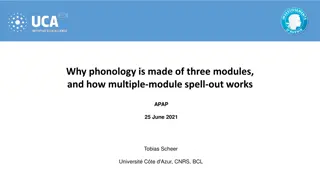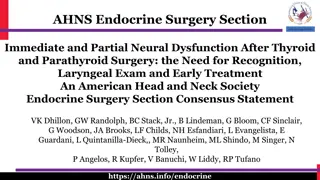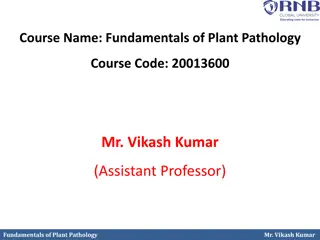Understanding Laryngeal Tumours: Types, Classification, and Pathology
Laryngeal tumours can be benign or malignant, with different types such as papilloma, chondroma, paraganglioma, and squamous cell carcinoma. These tumours present with various symptoms and may spread through direct, lymphatic, or hematogenous routes. Risk factors include tobacco smoking, alcohol consumption, and asbestos exposure, while clinical presentations can range from general symptoms to paraneoplastic manifestations. Pathologically, these tumours exhibit distinct characteristics that guide treatment approaches.
Download Presentation

Please find below an Image/Link to download the presentation.
The content on the website is provided AS IS for your information and personal use only. It may not be sold, licensed, or shared on other websites without obtaining consent from the author. Download presentation by click this link. If you encounter any issues during the download, it is possible that the publisher has removed the file from their server.
E N D
Presentation Transcript
Laryngeal tumours BY DR.ABDULLHUSSEIN KAREEM
Laryngeal tumours can be classified into benign and malignant. .Benign tumours are rare and include the following types. 1.Papilloma it may be single in adult or multiple in infants and children ,this type was discussed under the subject of stridor. 2.Chondroma it is more frequent in men ,present at the 6_7thdecade. It affect mostly the cricoid cartilage ,present with hoarseness and it is difficult to be differentiated from chondrosarcoma on histopathology. Treatment is by surgical excision.
3.Paraganglioma more frequent in women ,present at 4_6thdecade. It arises from laryngeal paraganglia ,highly vascular lesion, it presents with hoarseness and treated by conservative surgical excision. Other types like schwanoma,neurofibroma and lipoma are extremely rare. Malignant tumours like squamous cell carcinoma ,lymphoma and lymphoepithelial tumour. Squamous cell carcinoma . It is the most common malignant tumours in the head and neck region.
It is more common in men due to high consumption of tobacco and alcohol although the incidence started to rise in women . Pathology . Macroscopically ,the tumour may be exophytic or endophytic ,microscopically ,it is characterized by the presence of prickle cells and keratin whorls. The tumour may be well, moderately or poorly differentiated, the first type is radio resistant in contrast to the last one which is radiosensitive.
Spread ,the tumour may spread by the following routes; 1.Direct spread from the parts of the larynx to nearby structures like preepiglottic space ,thyroid cartilage ,tongue, pharynx and even skin. 2.Lymphatic ,spread of glottic cancer is less common than other sub sites due to lack of lymphatics in this area while supraglottic tumours spread rapidly to the lymph nodes because this sub site is rich in lymphatics and the patient may present with cervical lymphadenopathy before laryngeal symptoms ,the lymph nodes mostly involved are submandibular,jugulodigastric,juguloomyohyoid and occipital groups.
Haematogenous spread to the lung, liver and bones. Risk factors; 1.Tobacco smoking. 2.Alcohol drinking . 3.Asbestos exposure. Clinical presentations. 1.General ; Laryngeal cancer may present with general symptoms like weight loss, anemia and paraneoplastic symptoms like neuropathy and rash.
Glottic cancer; Change of voice or hoarseness is the early symptom and any patient has hoarseness that continues for more than 3 weeks should be subjected for laryngeal examination by laryngoscope. Advanced lesions may lead to airway obstruction causing progressive dyspnea and stridor . Hemoptysis is usually associated with larger tumours. Referred otalgia is a sinister sign suggesting deep invasion. Dysphagia and odynophagia are rare and indicate advanced disease. Cervical lymphadenopathy is rare presenting symptom .
Supraglottic cancer; Change of voice ,voice alteration is different from that seen with glottic and subglottic cancer. Small supraglottic lesions may present with globus or foreign body sensation . Hemoptysis in exophytic lesions. Hot potato voice in large lesions. Hoarseness if there is extension to the vocal cords. Referred otalgia ,odynophagia and true dysphagia indicate lateral extension of the tumour. Cervical lymph adenopathy may the first presenting symptom without any laryngeal symptoms . Stridor is late presentation and indicates advanced cancer.
Subglottic cancer; Globus felling or foreign body sensation in the throat. Hoarseness due to glottic or recurrent laryngeal nerves involvement. Progressive dyspnea and stridor in circumferential lesions. The tumour may involve the thyroid and may mimic a thyroid isthmus lesion. Examination; It includes general and ENT examination.
ENT examination; It includes complete examination by endoscope to check the site of the lesion,extension to the adjacent subsites,pyriform fossa,base of the tongue and check the mobility of the vocal cords . Neck examination to detect the cervical lymphadenopathy and thyroid gland to exclude its involvement. Drawing of the findings and video_recordings for documentation and follow_up .
Radiology ; 1.CT scan. Laryngeal tumours on CT scan are typically of soft_ tissue attenuation and enhance with intravenous contrast media. 2.MRI . The tumour has high water content and so has high intrinsic contrast on T2-weighted MRI . Both CT and MRI are complementary in detection of the tumour,its size ,extension and cartilage invasion. It is better to do radiological examination before taking biopsy because taking biopsy will affect the size and extension of the tumour.
Endoscopy and biopsy. Any patient with suspected laryngeal mass should be subjected for direct laryngoscopy (DL) and taking biopsy under general anesthesia. Complete investigations should be done for the patient before surgery in addition to ECG and chestX-ray . The patient should be informed that tracheostomy may be needed during or after surgery. The biopsy taken should be representative and not taken from necrotic areas. While the patient under GA ,we can asses the neck well for the presence or absence of cervical lymphadenopathy. At recovery from anesthesia,vocal cord mobility can be checked.
Staging of the tumour ; Any tumour should be staged clinically to know the size of the tumour ,extension,lymph node involvement and distant metastases. Staging will detect the type of treatment required and predict the prognosis . The single most prognostic factor in head and neck tumours is the presence or absence of lymph adenopathy. The laryngeal cancer is curable disease and this will put a burden on the otolaryngologist to discover it early and treat it well.
Staging of the laryngeal carcinoma (T staging) depends on the sub site but the (N and M) staging is the same for all. Treatment; As mentioned previously, the type of treatment depends on the site of tumour ,size and the presence or absence of lymph nodes. Treatment requires a multidisciplinary team including surgeons,radiotherapists,physicians and speech therapists. Early_stage disease may be treated endoscopically or with radiotherapy. Advanced disease may be treated with laryngectomy or chemo radiotherapy.
1.Radiotherapy; This type of treatment is indicated for early(T1) tumours but scrupulous follow-up is needed to detect the recurrence early. It may be complicated by laryngeal perichondritis which may require heavy antibiotics and even admission to hospital. It may be given before or after surgery. 2.Chemotherapy. It can be given alone for the patient or in combination with radiotherapy
3.Endoscopic resection. It is indicated for early lesions ,and can be done with the aid of CO2 laser and should be done by expert surgeon. 4.Laryngectomy . It is partial or total removal of the larynx and may be classified into the following; A.Partial laryngectomy which includes partial vertical(cordectomy) and partial horizontal laryngectomy. B.Total laryngectomy which includes removal of the whole larynx with its cartilages in addition to partial thyroidectomy, strap muscles and hyoid bone and the patient will be left with permanent tracheostomy.
5.Treatment of the lymph nodes . Treated by radiotherapy or surgery(neck dissection)













